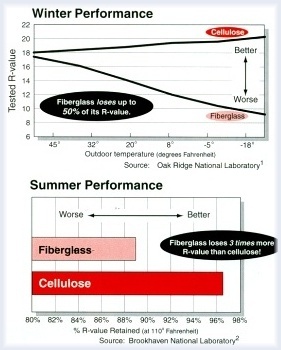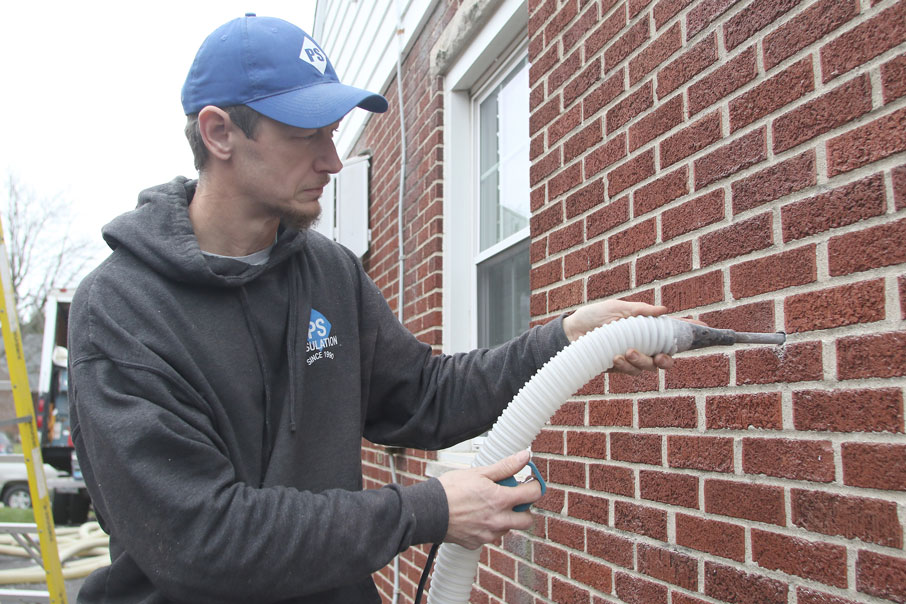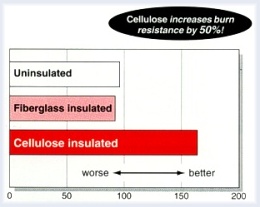Cellulose vs. Fiberglass
The following is a summary of an extensive Natural Resources Defense Council (NRDC) report. The NRDC is a non-profit environmental membership organization with over 300,000 members and contributors nationwide:
See why Cellulose is superior to FiberglassThe NRDC has concluded the following:
- Cellulose insulation manufactured from recycled paper is the least polluting and most energy efficient insulation.
- Cellulose has the highest post-consumer recycled content. The fiberglass industry averages 35% recycled glass, while the cellulose industry averages a minimum of 75% recycled content.
- It takes more than 10 times as much energy to produce fiberglass insulation as cellulose insulation.
- Due to air circulation and natural convection, the R-value of blown-in fiberglass insulation decreases by as much as 50% as the temperature drops from 45Fº to 18Fº.
- Cellulose has better resistance to air flow and prevents the upward movement of air caused by temperature differences (the R-value of cellulose actually improves during cold weather).
- Substantial and well-documented public health threats are associated with fiberglass.
- No adverse health effects from cellulose insulation have been identified.
Why Cellulose?
- Cellulose that has been properly installed in your walls will not settle.
- Cellulose is non-corrosive to steel, copper and aluminum.
- Cellulose will not lose its energy saving abilities over time.
- Cellulose will not rot, decay or mildew, and it does not support fungus or mold growth.
Will My Choice of Insulation Really Effect My Monthly Heating & Cooling Bills?
 YES! Utility bills were 32% lower in the cellulose insulated building.
YES! Utility bills were 32% lower in the cellulose insulated building.
~ Leominster Housing Authority
Different insulations are made from fundamentally different materials. Tests at Oak Ridge and Brookhaven National Laboratories and the University of Illinois reveal that insulations with the same laboratory R-values do not perform equally in real homes. Researchers found that the effective R-value of blown fiberglass plunges during cold weather, while the effective R-value of cellulose actually increases. The researchers also discovered that summer temperatures offer no relief for fiberglass, since its effective R-value withers then, too.
Call today for FREE Estimate
Cellulose Exceeds Tough Fire Standards
 Cellulose insulation is the only building material in your home that is commonly treated with fire retardants. The result is exceptional insulation that meets or exceeds required fire safety standards and helps protect you and your family. Cellulose insulation actually helps make homes safer by providing up to 50% better fire resistance than fiberglass. In practical terms, this means that occupants have more time to reach safety in case of fire. Unlike fiberglass, it greatly restricts the amount of oxygen available to support combustion.
Cellulose insulation is the only building material in your home that is commonly treated with fire retardants. The result is exceptional insulation that meets or exceeds required fire safety standards and helps protect you and your family. Cellulose insulation actually helps make homes safer by providing up to 50% better fire resistance than fiberglass. In practical terms, this means that occupants have more time to reach safety in case of fire. Unlike fiberglass, it greatly restricts the amount of oxygen available to support combustion.
 "11 minutes into the burn the ceiling of the uninsulated house collapsed, 10 minutes later the ceiling of the fiberglass insulated house also collapsed. The ceiling of the cellulose house did not collapse until 1 hour and 10 minutes after the burn started."
"11 minutes into the burn the ceiling of the uninsulated house collapsed, 10 minutes later the ceiling of the fiberglass insulated house also collapsed. The ceiling of the cellulose house did not collapse until 1 hour and 10 minutes after the burn started."
(Insulator's Guide, news account of fire demonstration)


